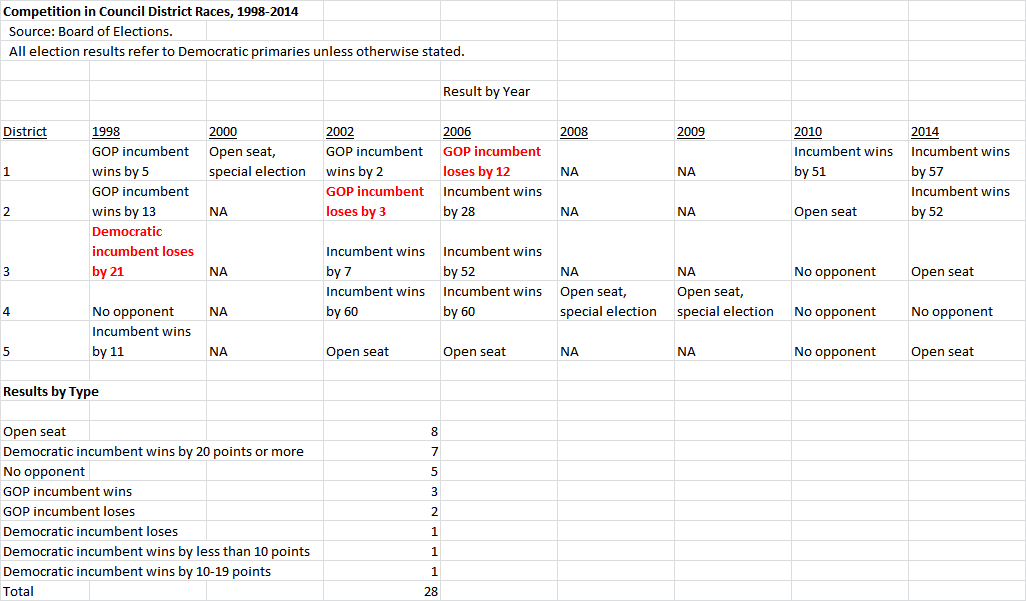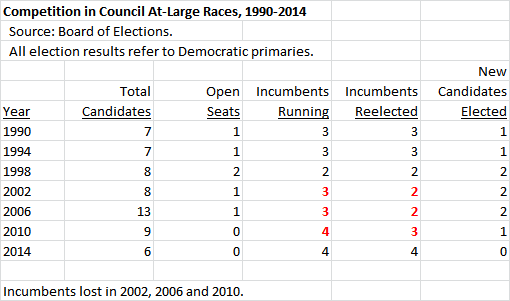By Adam Pagnucco.
Recently, MoCo’s political community has been thinking of changing the structure of the County Council. Since 1990, the council has had four at-large members and five members elected by residents of districts. One idea is to reduce or eliminate the at-large members and replace them with more district members. Advocates of that perspective believe the districts are too large, that district members are more responsive than at-large members and that the cost of running at-large enables interest groups to play more in those elections. We offer no opinion on any of those theories, but prior election history points to one consequence of shifting to an all-district council.
The level of political competition will almost certainly decline.
Why do we believe that will happen? Consider recent elections. Below is a chart showing the results of all district council elections since 1998. Over that period, there have been 28 district council elections, 20 of which featured incumbents. The incumbents won 17 of 20 races, an 85% win rate. If the Republican incumbents are omitted, the remaining Democratic incumbents won 14 of 15 elections, a 93% win rate.
If that is not enough to prove the non-competitiveness of these elections, consider just two facts. First, only one Democratic district incumbent has lost under our current structure, and that happened in 1998. Second, of the last six contested district races, five saw the incumbent win by more than fifty points.
Meanwhile, the at-large races are much more competitive. Since the current system was established in 1990, no group of at-large incumbents has ever run unopposed. Three Democratic incumbents have lost – Blair Ewing (2002), Mike Subin (2006) and Duchy Trachtenberg (2010). Even in the two elections in which all four incumbents ran for reelection (2010 and 2014), challengers still entered the race and one of them (Hans Riemer in 2010) knocked out an incumbent to win.
This year, those same trends continue unabated. There are 25 at-large candidates (with more to come) running with three seats open. Meanwhile, district incumbents Nancy Navarro (D-4) and Tom Hucker (D-5) have no opponents while Craig Rice (D-2) has token opposition in the primary. Only Sidney Katz (D-3) has a serious challenger. This disparity persists even in the presence of public financing, which was supposed to promote competition.
What explains this pattern? After all, district races are theoretically cheaper than at-large races because they have fewer voters. The reason is that one-seat races against incumbents are very different affairs than at-large contests. A challenger running against an incumbent for one seat must show that the incumbent has committed a firing offense; otherwise, voters will support the candidate they know better. These one-seat races can turn nasty as we have seen from recent MoCo Senate elections as well as the bitter fight between Council District 5 incumbent Derick Berlage and challenger Marc Elrich twenty years ago. At-large races are seldom negative unless slates are formed to compete against each other. (That hasn’t happened since 2002.) At-large challenger Hans Riemer ran a model race in his 2010 win, promoting his policy agenda of progressivism and smart growth and never targeting any single incumbent for criticism. Most candidates don’t have the stomach for negative elections when an open seat is available. And in six of the last eight at-large races (including next year), at least one seat has been open.
Political competition is extremely valuable. It should not be discarded lightly. There may be good reasons to increase the number of districts, but if at-large members are completely eliminated, voters will pay the price with fewer choices and less accountability at election time.


